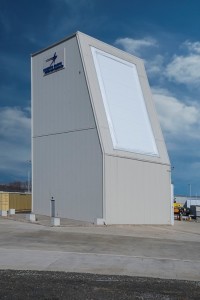The Missile Defense Agency (MDA) is planning to upgrade the Long Range Discrimination Radar (LRDR) and is seeking information from possible vendors on capability to meet the requirements.
According to a May 27 Request For Information (RFI), MDA said it is conducting market research “to determine industry interest and capability to meet emerging requirements” for LRDR that particularly aim to improve missile defense and U.S. Space Force tracking.

Lockheed Martin [LMT] is the prime contractor for LRDR, which will consist of two radar antenna arrays made of 10 panels each. LRDR is an S-band radar the agency is procuring to help improve its ability to distinguish between ballistic missile threats and other objects or decoys at longer ranges. LRDR is being built in Clear, Alaska.
The RFI doubled as a Notice of Intent to Sole Source, implying Lockheed Martin will conduct this work.
MDA said the potential scope of the work is to adapt existing LRDR Configuration 1, planned to be fielded in 2021, to be upgraded with new Software enhancements to Increment 6c/7. That would lead to a new deployment of the system in December 2023.
In March, Lockheed Martin said it delivered the first 10 LRDR panels and all were expected to be installed by the end of the month. A company spokesperson told Defense Daily at the time the company expected to deliver the last 10 panels through June, all equipment delivered by the third quarter of 2020, and for total system delivery to be completed by the end of the year (Defense Daily, March 10).
The RFI split LRDR’s upgrade major requirements into four areas.
The notice said MDA’s Ballistic Missile Defense (BMD) System needs “consistent and accurate real-time bias monitoring and reduce to support accurate correlations and integration of BMD System Track.”
Therefore the requirement would modiy LRDR Configuration 1 to perform Active Sensor Bias Monitoring and Reporting.
MDA also said it is exploring using LRDR for the U.S. Space Force. It explained the Space Force “needs improved functionality to support Space Domain Awareness (SDA) and Space Object Identification (SOI) mission areas.”
The requirement would modify LRDR to enhance the existing BMD and SDA radar capabilities to include SDA and SOI functions.
The notice argued operators need the flexibility to operate the LRDR BMD and SDA mission areas with one or more lower, fixed power states. “This requirement adapts the existing LRDR operations to operate at lower fixed power states with the ability to rapidly ramp up to high power states as required to achieve mission success performance requirements.”
This aims to improve power consumption and reduce operational costs over the radar’s life cycle without impacting BMDS mission performance.
MDA is also looking to integrate LRDR with Command and Control, Battle Management and Communications (C2BMC). The upgrade effort envisions adapting the existing radar tactical software with enhancements to operate with C2BMC.
C2BMC is the integrating element of the ballistic missile defense system that provides situational awareness and battle management capability while pulling together various sensors to different interceptors. The system has been in operation since 2004 and is worked through a team led by Lockheed Martin.
The notice said the last effort “includes interface definition, developmental testing (laboratory and site testing) at Clear Air Force Station (CAFS), pairwise testing, and BMDS integrated ground and flight testing.”
The fourth upgrade effort is nothing new. Last August, Lockheed Martin said it won a $320 million contract in March 2019 to extend its work as lead on the C2BMC team to integrate LRDR into the system (Defense Daily, Aug. 6, 2019).
The LRDR work, along with adding other sensors providing tracking capabilities, is set to be integrated into the latest C2BMC spiral, or software version. That contract extended C2BMC work through December 2022.
The C2BMC team also includes Northrop Grumman [NOC], Boeing [BA], Raytheon Technologies [RTX], and General Dynamics [GD].
MDA underscored the RFI was issued only for information and planning purposes without a promise to issue a Request for Proposals and does not establish any contracts.
Questions about the RFI are due by June 5 while final responses are due June 12.